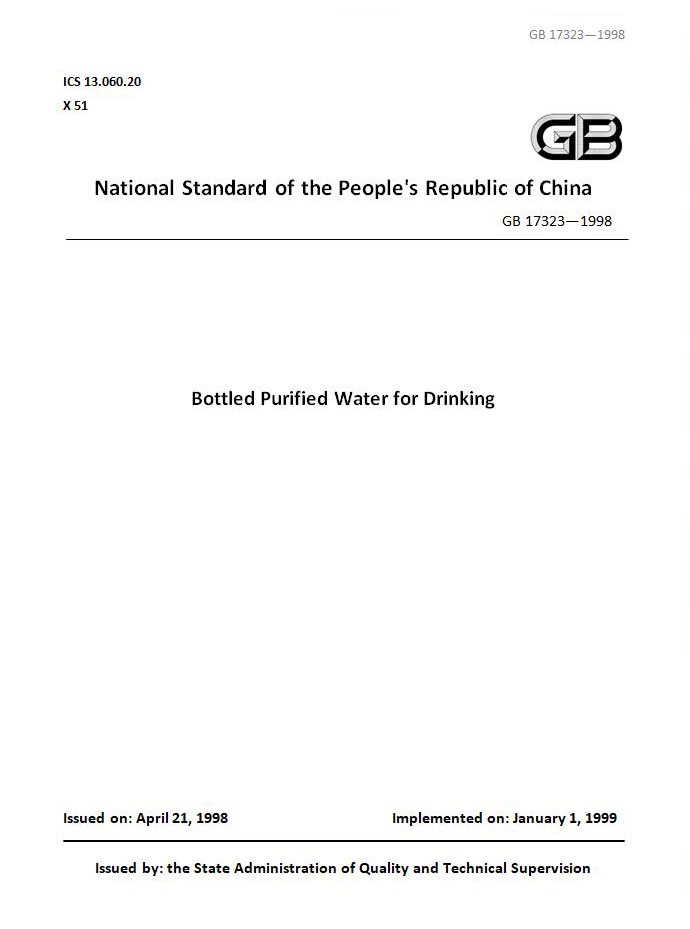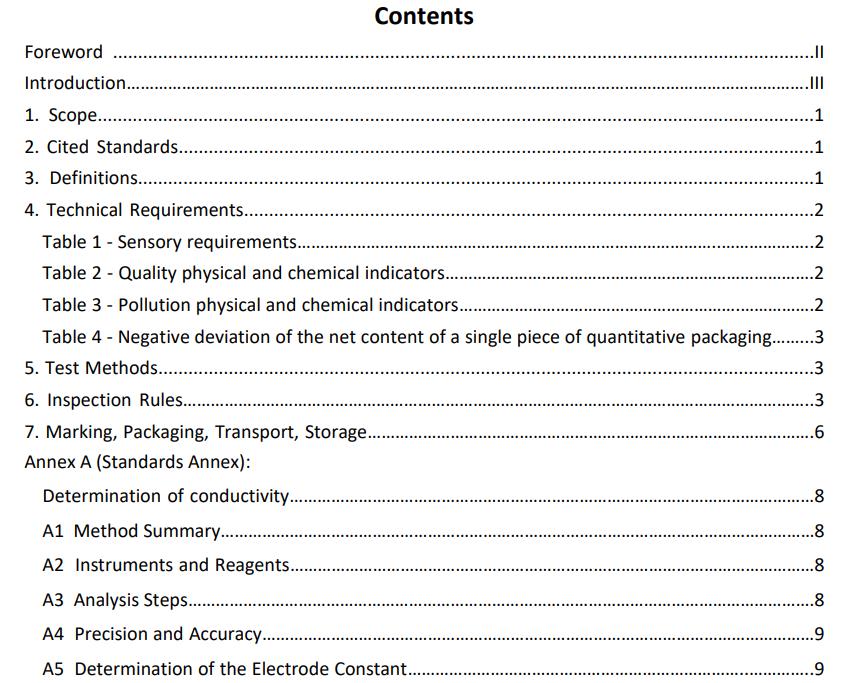Bottled Purified Water for Drinking
National Standard of the People's Republic of China
Standard Number: GB17323-1998
Publish date: 1998-04-21
Implement date: 1999-01-01
Issued by: The State Administration of Quality and Technical Supervision
Standard Status: Partially valid. Some of the contents were replaced by "GB 19298-2014 Packaged Water for Drinking".
This is GB17323-1998, the quality standard of bottled purified water for drinking, a food standard of the People's Republic of China. It is issued by the State Administration of Quality and Technical Supervision.
The English version of this standard is translated from the Chinese original GB17323-1998. In case of discrepancies in the translated version, the original Chinese standard GB17323-1998 (Chinese version) shall prevail. This translated version can provide reference for food production enterprises.
Standard Text of GB17323-1998
A. Standard Cover of GB17323-1998

B. Table of contents

C. Standard Preface of GB17323-1998
Foreword
This standard is a product standard for bottled purified water for drinking. Its definition and scope refer to the revised standard of "bottled water" issued by the United States Food and Drug Administration (FDA) in 1993.
The test method of "Conductivity" is listed in Appendix A of this standard.
This standard was proposed by the China Light Industry Association.
This standard shall be under the jurisdiction by the China National Food Fermentation Standardization Center.
This standard is drafted by the China Food Fermentation Industry Research Institute, the Guangzhou Station of China Light Industry Association of Quality Supervision and Inspection, the Shenzhen Yibao Food and Beverage Co., Ltd., the Zhaoqing Dinghu Distilled Water Co., Ltd., the Shenzhen Jingtian Food and Beverage Co., Ltd., and the Guangdong Jianlibao Beverage Factory.
The main drafters of this standard: Xu Qingqu, Zhou Dafa, Wang Yi, Wu Musheng, Zhou Jingliang, Deng Ruiwen.
This standard shall be interpreted by the China National Food Fermentation Standardization Center.
D. Total Pages: 12, (including cover, Table of Contents, preface and contents)
Total Words: 2483, (including cover, Table of Contents, preface and contents)
E. Standard Content of GB17323-1998
National Standard of the People's Republic of China
Bottled Purified Water for Drinking
1. Scope
This standard specifies technical requirements, test methods, inspection rules and markings, packaging, transportation and storage requirements for bottled purified water for drinking. It is applicable to products that meet the definition of Chapter 3 of this standard.
2. Cited Standards
The clauses contained in the following standards constitute clauses of this standard through being cited by this standard. The versions shown are valid at the time of publication. All standards are subject to revision, and parties using this standard should explore the possibility of using the latest versions of the standards listed below.
GB 191—90 Packaging — Pictorial Marking for Handling of Goods
……
6. Inspection Rules
……
6.2 Inspection before leaving the factory
6.2.1 Before the products leave the factory, the inspection department of the factory shall inspect it batch by batch according to the provisions of this standard. After passing the inspection, a certificate of quality conformity is issued. And the signed quality certificate is attached to the box (in or outside the box). The products can leave the factory.
6.2.2 Sampling method and quantity
Each batch is randomly sampled 15 bottles (cans), (6 bottles are sampled above 2L). 6 bottles (cans) (2 bottles above 2L) for sensory requirements, net content, pH, conductivity testing, [net content determination 3 bottles (cans) (2L above 2 bottles)]; 3 bottles (cans) (2 bottles above 2L) for the detection of the total number of colonies and coliform; The other 6 bottles (cans) (2 bottles above 2L) are kept samples for later use. [Please read the translator note to paragraph 6.2.2]
[Translator note to 6.2.2]: For products with a volume of less than 2L, from any batch of product, 15 bottles (cans) are randomly sampled per batch; Among them:
……
6.3.2 Sampling method and quantity
From any batch of products, 18 bottles (cans) are randomly sampled (6 bottles are sampled over 2L). 9 bottles (cans) (2 bottles, over 2L) for the inspection of sensory requirements, net content, physical and chemical indicators [Net content determination 3 bottles (cans) (2 bottles, over 2L)]; 3 bottles (cans) (2 bottles, over 2L) for microbial testing; The other 6 bottles (cans) (2 bottles, above 2L) are kept samples for later use. [Please read the translator note to paragraph 6.3.2]
[Translator note to 6.3.2]: For products with a volume of less than 2L, from any batch of product, 18 bottles (cans) are randomly sampled. Among them:
……
Annex A
(Standards Annex)
Determination of conductivity
A1 Method Summary
Conductivity is refers to the reciprocal of resistance measured between two electrodes at a distance of 1 cm and a cross-sectional area of 1 cm2, which is read directly by a conductivity meter.
A2 Instruments and Reagents
A2.1 Instruments
A2.1.1 Conductivity meter (with supporting conductivity electrode).
……
A3 Analysis Steps
According to the instructions for use of the conductivity meter, select the electrode and measurement conditions, and adjust the conductivity meter. After washing the electrode 3 times with the solution to be measured, insert it into the beaker (A2.1.2) [Translator note: it should be A.2.1.3] containing the solution to be measured. Select the appropriate range and read the reading on the meter to calculate the conductivity value of the solution to be measured.
……
A5 Determination of the Electrode Constant
Take the electrode with unknown electrode constant, wash it 5 times with potassium chloride standard solution (A2.2), insert it into a beaker containing potassium chloride standard solution (A2.2), and measure the conductivity at a certain temperature to calculate the electrode constant.
Electrode constant = K/S ………. (A1)
In the formula:
……
________________________________
Note: Commonly used Chinese food standards include mandatory national standards (the code starts with "GB") and recommended national standards (the code starts with "GB/T")
If you need other Chinese standards related to food, please "Contact Us". We do our best to find and provide translation services.
----------------------------------------------------
To obtain the text of this standard (English version), a payment of 50 US dollars ($50) is required. Payment can also be made in RMB, Euro, British pound, Australian dollar, New Zealand dollar, Canadian dollar, Thai baht, Swiss franc, and ruble. Payment can be made by Visa, UnionPay, credit card, debit card, wire transfer, Paypal, Alipay and WeChat. After payment, please tell us your payment name, country and location where payment is made, payment time, and email address for receiving documents in "Contact Us". If you still haven't received the document after 1 day after payment, please "contact us" so that we can solve it in time. When the document is received, please reply "Document received". If there is no response within 10 days, we consider the document to have been received. You can also ask for help through "Contact Us".
----------------------------------------------------
References Articles
1. GB5749-2006 Standard for Drinking Water Quality
2. GB5749-2022 Standard for Drinking Water Quality
3. GB8537-2018 Drinking Natural Mineral Water
4. GB/T6682-2008 Water for Analytical Laboratory Use - Specifications and Test Methods
5. GB5009.16-2014 Determination of Tin in Food 1 - National Food Safety Standard
6. GB5009-268 Determination of Multiple Elements in Food 1
7. GB14881-2013 General Hygienic Regulation for Food Production
8. GBT/27341-2009 Hazard Analysis and Critical Control Point (HACCP) System - General Requirements for Food Processing Plant
----------------------------------------------------
Related Equipment
1. Drinking Water Revers Osmosis (RO) Purification Treatment Equipment: can be used in the production of beverages, purified water and other food.
2. River and Lake Drinking Water Purification Treatment Equipment: can treat raw water of rivers and lakes into drinking water, is ideal drinking water purification treatment equipment for a water plant.
3. Food Safety Testing and Inspection instruments Equipment: are used for inspection of pesticide residues, heavy metals.
4. Microbiology Testing Equipment and Instruments: include incubators, gadgets, and instruments, are one of the food safety testing equipment.
5. Laboratory Equipment and Instruments: include precision weighing equipment, evaporators, drying ovens and food testing instruments.
6. Food Production Monitors and Online Detectors: are capable of detecting and monitoring the quality of each product on the food production line, is important testing equipment.
---------------------------------------------------- 
